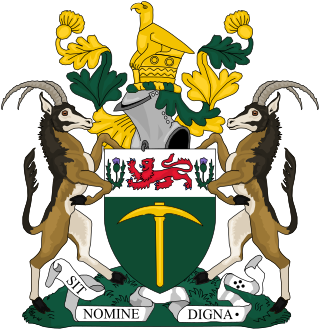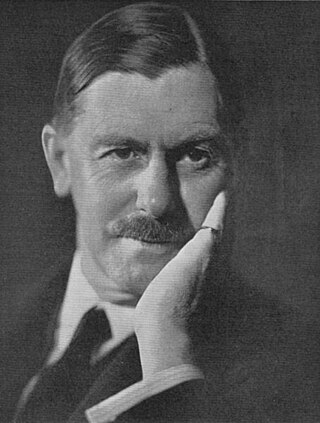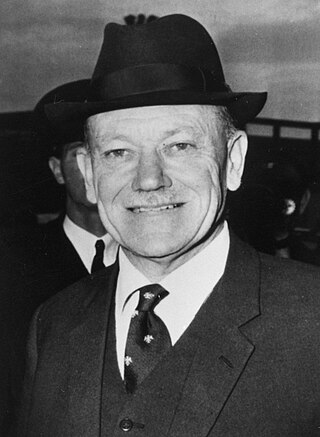History
Rhodesia Party (1923–34)
Coghlan became the first Premier of Southern Rhodesia, and the party continued as the Rhodesia Party, which had a broader base of support, including a number of former unionists in its cabinet. [1] It remained in power until September 1933, when the party narrowly topped the popular vote, but lost the election, winning only nine of the 30 seats compared to the Reform Party's 16. [3] Although the Reform Party was left-wing in name, many of its leading members, including the new prime minister Dr Godfrey Huggins, were politically conservative; the Rhodesia Party merged with the Reform Party's more rightist members in 1934 to form the United Party. [4]
Legacy
With Huggins at the helm, the United Party roundly defeated the rump left wing of the Reform Party in an election held the same year. [4] The United Party thereafter remained in government for nearly three decades, with Huggins leading it until his retirement in 1956. The party renamed itself the United Rhodesia Party in 1953, soon after Southern Rhodesia was federated with Northern Rhodesia and Nyasaland, and merged with the Federal Party in 1958 to become the United Federal Party. Its leaders included Garfield Todd and Edgar Whitehead, both of whom pursued mildly reformist policies which led to expanded political participation by black Africans. It was removed from power by the Rhodesian Front's 1962 electoral victory, and was inactive by 1965. [5]
The Rhodesia Party name was revived twice. Following the UFP's electoral defeat in 1962, the opposition would regroup under the RP moniker and Roy Welensky unsuccessfully attempted to re-enter Parliament, pursuing a moderate platform in opposition to the RF government and UDI. In 1973, the name was revived again by white moderates who entered the 1974 election on a reformist platform but won no seats.

Southern Rhodesia was a landlocked self-governing British Crown colony in southern Africa, established in 1923 and consisting of British South Africa Company (BSAC) territories lying south of the Zambezi River. The region was informally known as south Zambesia until annexed by Britain at the behest of Cecil Rhodes's British South Africa Company, for whom the colony was named. The bounding territories were Bechuanaland (Botswana), Northern Rhodesia (Zambia), Portuguese Mozambique (Mozambique), and the Transvaal Republic.

The prime minister of Rhodesia was the head of government of Rhodesia. Rhodesia, which had become a self-governing colony of the United Kingdom in 1923, unilaterally declared independence on 11 November 1965, and was thereafter an unrecognized state until 1979. In December 1979, the country came under temporary British control, and in April 1980 the country gained recognized independence as Zimbabwe.

Sir Roland "Roy" Welensky was a Northern Rhodesian politician and the second and last Prime Minister of the Federation of Rhodesia and Nyasaland.

Sir Charles Patrick John Coghlan,, was a lawyer and politician who served as Premier of Southern Rhodesia from 1 October 1923 to his death. Having led the responsible government movement in the territory during the latter days of Company rule, he was Southern Rhodesia's first head of government after it became a self-governing colony within the British Empire.
Legislative Council elections were held in Southern Rhodesia on 30 April 1920, the seventh elections to the Legislative Council.

General elections were held in Southern Rhodesia on 29 April 1924, the first elections to the new Legislative Assembly following the granting of responsible government to the colony. The result was a comprehensive victory for the Rhodesia Party, which had been formed by the supporters of responsible government, who won 26 out of the 30 seats.
General elections were held in Southern Rhodesia on 6 September 1933, the third elections since the colony of Southern Rhodesia was granted self-government. It is notable as one of only two general elections in Southern Rhodesia which led to a defeat for the sitting government, as the Reform Party won a narrow majority of two seats in the Legislative Assembly. Their victory was to be short-lived.

The Rhodesian Air Force (RhAF) was an air force based in Salisbury which represented several entities under various names between 1935 and 1980: originally serving the British self-governing colony of Southern Rhodesia, it was the air arm of the Federation of Rhodesia and Nyasaland between 1953 and 31 December 1963; of Southern Rhodesia once again from 1 January 1964; and of the unrecognised nation of Rhodesia following its Unilateral Declaration of Independence from Britain on 11 November 1965.
General elections were held in Southern Rhodesia on 7 November 1934, fourth elections since the colony of Southern Rhodesia was granted self-government. The elections were called only a year after the previous elections when the Prime Minister, Godfrey Huggins, formed the United Party as a merger of the conservative section of his Reform Party and the former governing Rhodesia Party. Huggins succeeded in winning a landslide, defeating all but one of his Reform Party opponents.
General elections were held in Southern Rhodesia on 14 April 1939, the fifth elections since the colony of Southern Rhodesia was granted internal self-government. Prime Minister Godfrey Huggins' United Party government were re-elected in a landslide. The elections were called slightly earlier than the deadline as Huggins feared the German invasion of Czechoslovakia would lead to European War.

The Rhodesia Labour Party was a political party which existed in Southern Rhodesia from 1923 until the 1950s. Originally formed on the model of the British Labour Party from trade unions and being especially dominated by railway workers, it formed the main opposition party from 1934 to 1946. The party suffered a catastrophic split during the Second World War and lost all its seats, and a further split over the attitude to the Federation of Rhodesia and Nyasaland ended its involvement in Rhodesian politics.
General elections were held in Southern Rhodesia on 25 April 1946, seven years after the previous elections in 1939, the term of the Southern Rhodesian Legislative Assembly having been extended so that there would be no general elections during World War II. The elections showed a strong shift to the right, as the United Party government led by Prime Minister Godfrey Huggins lost its overall majority; however, Huggins could count on the support of one of the factions of the Rhodesia Labour Party in any vote of confidence and therefore remained in office.
General elections were held in Southern Rhodesia on 15 September 1948. They saw Prime Minister Godfrey Huggins regain the overall majority he had lost in the previous elections in 1946. Huggins' United Party won a landslide, reducing the opposition Liberal Party to a small minority.

The Federation of Rhodesia and Nyasaland, also known as the Central African Federation (CAF), was a colonial federation that consisted of three southern African territories: the self-governing British colony of Southern Rhodesia and the British protectorates of Northern Rhodesia and Nyasaland. It existed between 1953 and 1963.

The modern political history of Zimbabwe starts with the arrival of white people to what was dubbed Southern Rhodesia in the 1890s. The country was initially run by an administrator appointed by the British South Africa Company. The prime ministerial role was first created in October 1923, when the country achieved responsible government, with Sir Charles Coghlan as its first Premier. The third Premier, George Mitchell, renamed the post Prime Minister in 1933.

Godfrey Martin Huggins, 1st Viscount Malvern, was a Rhodesian politician and physician. He served as the fourth Prime Minister of Southern Rhodesia from 1933 to 1953 and remained in office as the first Prime Minister of the Federation of Rhodesia and Nyasaland until October 1956, becoming the longest serving prime minister in British Commonwealth history, until 1961.

Sir Thomas Hugh William Beadle, was a Rhodesian lawyer, politician and judge who served as Chief Justice of Southern Rhodesia from March 1961 to November 1965, and as Chief Justice of Rhodesia from November 1965 until April 1977. He came to international prominence against the backdrop of Rhodesia's Unilateral Declaration of Independence (UDI) from Britain in November 1965, upon which he initially stood by the British Governor Sir Humphrey Gibbs as an adviser; he then provoked acrimony in British government circles by declaring Ian Smith's post-UDI administration legal in 1968.
Harry Herbert Davies was a Southern Rhodesian Labour politician and Leader of the Opposition in the territory's Legislative Assembly from 1929 to 1944. Originally from Wales, he moved to Southern Rhodesia in 1920 and became an estate agent in Bulawayo. He ran for the Southern Rhodesian Labour Party in Bulawayo District in the 1924 general election, but was not elected. After standing successfully in Bulawayo South in the 1928 election, he sat in the Southern Rhodesian Legislative Assembly for 20 years. In 1929 he was elected leader of the Southern Rhodesian Labour Party, thereby becoming Leader of the Opposition, a post he held until 1944.
The Reform Party was a political party that was formed in Southern Rhodesia in 1932, which went on to form the government under Godfrey Huggins in 1933, before splitting in 1934 and disappearing by the end of the decade. The party had support from disenchanted Rhodesian settlers including "railway men, civil servants, artisans without a job and farmers in economic distress." Its initial program proposed the creation of a central bank to regulate the colony's currency and credit and other measures to provide economic support for white workers and farmers facing competition from low paid African workers and manufacturers facing competition from cheaper South African imports.
Jacob Hendrik Smit, CMG was a Southern Rhodesian merchant and politician. Born in the Netherlands, Smit migrated to Rhodesia and traded as a merchant, before becoming Southern Rhodesia's Minister of Finance in 1933. Orthodox in his economic policies, Smit resigned from Godfrey Huggins' government in 1942 and later formed the right-wing Liberal Party. He was Southern Rhodesia's Leader of the Opposition from 1946 to 1948, when he lost his seat.









